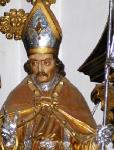| A Little Background Music for the Witch Burnings |
| When Archbishop Max Gandolph wasn't busy burning witches and banishing Protestants, he enjoyed good music. One of the great musicians attached to the court during the time of our story was Heinrich Ignaz Franz von Biber, 1644 - 1704. Biber was one of the first truly great instrumental composers and perhaps the best violinist of the 17th century. He was born on a large estate, where his father was huntsman. By the mid 1660s, he was in the orchestra of Prince- Bishop Karl Lichtenstein-Kastelkorn of Olmütz. Biber felt he could do better elsewhere, and in 1670, he left without permission. The Prince-Bishop issued an arrest warrant for him (only to forgive him later). Biber hid out with an instrument maker in the South Tyrol, Jakob Stainer, who spread the word that Biber was truly a "formidable virtuoso." Biber obtained a job with the court of Max Gandolph in Salzburg during the winter of 1670. Here, he won a series of promotions: trainer of the cathedral choir boys, dean of the boys' school and, finally, Court Kapellmeister, a post Biber held until his death. In May 1672, Biber married, and would lose no fewer than seven of his eleven children to premature death. He was awarded a patent of nobility by Emperor Leopold I in 1690. Biber is best known to history for his violin music, however he also wrote two operas and much religious music.Very little of Biber's music has survived. One massive work thought to be composed by Biber was rescued by a horrifed Salzburg choirmaster who discovered that his grocer was wrapping fish in sheets of the music. The Salzburg court employed scribes or copyists to write down the various church music in the 17th and 18th centuries, and watermark evidence on the paper they used often helps date compositions. In 1672, Archbishop Max Gandolph had a chaplain's house built and attached to St Georg's Chapel in which there was additional space to house a music school and living quarters for the teacher. The Choirboys' Institute housed, fed, educated and clothed about sixteen choirboys who sang in the Cathedral, all at the court's full expense. Here they were taught by court musicians such as Biber. Through most of the seventeenth century, there were at least seventy-five to eighty cathedral and court musicians and about fifty regularly performing vocal music. A Cathedral mass was comprised of numerous instrumentalists and vocalists in various locations around the building: at ground level, on both sides and also in the four organ galleries, for a type of "surround sound" effect. During the early 1670s, Salzburg Archbishop Maximilian Gandolph actively promoted rosary devotion in Salzburg and Biber wrote his Mystery or Rosary Sonatas, his most famous compositions. The Salzburg archbishops loved grandiose services in the cathedral in which all available musicians took part, and there were plenty of them. Not only were there many musicians available, there were several other musical training institutions in Salzburg as well. |
| THE SALZBURGERS |
| The Archbishops fully enjoyed their exulted positions and certainly didn't allow their egos to get in the way of a good representation of themselves. At the Jesuit church St. Francis Xavier in Leoben, built in 1660, the gorgeous altar statue of St. Virgil Of Salzburg, who died in the year 784, was modeled after none other than Archbishop Max Gandolph (click) |
| Left: Biber's Mystery Sonatas |
